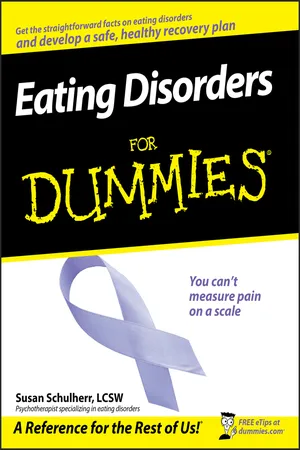In this part . . .
I include chapters that tell you how eating disordered behaviors harm your body and affect your thinking processes. I also review psychological and behavioral problems that commonly accompany eating disorders, such as addiction, compulsive exercise, depression, and suicidal tendencies. For all of these companion disorders, I provide tools to help you decide whether they apply to you (indicating you should seek evaluation and treatment).
Chapter 1
Understanding Eating Disorders
In This Chapter
Understanding what an eating disorder is
Finding out why eating disorders have been on the rise
Seeing a better future through treatment and recovery
The term eating disorder sounds like something that refers to somebody who doesn’t eat right. And, in one sense, it certainly does. Some people with eating disorders severely under-eat, to the point of risking their health or their lives. Others repeatedly overeat in extreme ways and may do risky things to get rid of the calories they’ve taken in. But what’s not right about the eating is far more complicated than calories and nutrition.
In this chapter you get an overall sense of the eating disorders as physical and psychological syndromes: What do they look and feel like? Who gets them? What is an eating disorder doing in a person’s life? How is getting an eating disorder driven by the culture, and how does that help us understand people with eating disorders better?
If you have an eating disorder, I tell you what you need to do to find treatment and get better. This previews Part II of this book, which covers treatments from soup to nuts. If you are a parent or caregiver to someone with an eating disorder, I discuss some of the difficulties of your situation. Part IV of this book, expanding on what I say here, is essentially a how-to section devoted to caregivers.
Getting a Sense of the Problem
People with eating disorders experience psychological issues and are compulsive in their eating habits. These play on each other over time, causing the eating disorder to become more entrenched. Some of the techniques used to try to drop a few pounds may lead to bad eating habits. However, if the concern about weight becomes obsessive, then the problem moves from simple dieting to an eating disorder.
Eating disorders involve the body and the mind. People with eating disorders express psychological problems through their behaviors with food. For example, someone who is struggling with self-esteem may decide that losing some weight would make them feel better and be a more appealing person. This person may try dieting, like many of her friends. But because she starts depending on dieting and weight loss for a sense of self-esteem, she can’t let go of them. They become an obsessive focus, and the problem moves from simple dieting to an eating disorder. Psychological problems that existed before the eating disorder developed get worse, not better, as a result.
Eating disorders can’t be separated from the culture in which they arise. In Western society, the overwhelming cultural message is that being thin is best. As people try to define themselves and what makes them valued members of the culture, the message to get or stay thin affects behavior such as eating, dieting, exercise, even cosmetic surgery. It may also affect self-image. I discuss in this section how these effects can lead to disordered eating habits even for a great many people who don’t have formal eating disorders. For some people who are otherwise vulnerable (see “Seeing What’s Behind the Symptoms” in this chapter and a discussion of risk factors for developing an eating disorder in Chapter 5), the message that thin is best provides the central principle for fixing their lives — and an eating disorder can soon follow. (Read “Understanding the Dramatic Rise in Eating Disorders,” later in this chapter, to find out more about the development of the “culture of thin.”)
In this section and throughout the book I give you a sense of what eating disorder symptoms are about in the belief that a solid understanding is necessary in order to arrive at the right kinds of solutions. I describe more about the cultural phenomenon of disordered eating practices, of which eating disorders represent the extreme end. I also give you a sense of who gets eating disorders and how many people have them.
Psyching yourself sick
For the person with an eating disorder, weight and eating develop into a psycholo...




